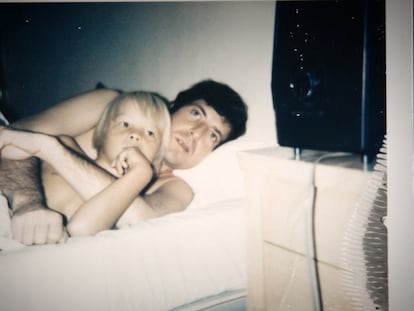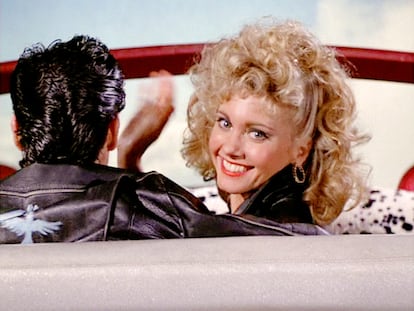The unpredictable hell of Woodstock 1999: Burning stages, sexual abuse and a stream of feces
Two documentaries detail the calamitous New York festival, which sought to emulate the legendary 1969 event but was shut down amid fires, riots, and violence


Woodstock 1999 began promising three days of “peace, love and music.” It ended with stages in flames, sound towers reduced to smithereens, tents razed to the ground, the press and performers running like hell, promoters barricaded in their offices, and thousands of hungover and exhausted young hooligans wallowing in a stream of feces. The San Francisco Examiner aptly called the event “the day live music died,” alluding to the day the music died, which Don McLean sang about in American Pie. On August 3, Netflix released Trainwreck: Woodstock ‘99, a documentary directed by Jamie Crawford. In three chapters of about 45 minutes each, Trainwreck offers a grisly post-mortem of what many consider one of the most chaotic music festivals in history.
Between Friday, July 23 and Sunday, July 25, 1999, in Rome, New York, a crime was committed against music, sanity, and decorum. If Crawford’s documentary makes anything clear, it’s that there were multiple perpetrators and even now none of them seem willing to take responsibility for the sorry episode.
Michael Lang, who created the Woodstock brand (and passed away last January), and John Scher, the event’s main promoter, were the first to pass the buck. Both had already been interviewed for Woodstock ‘99: Peace, Love and Rage, the HBO documentary that premiered last summer. In the earlier film, Lang and Scher blamed each other. In Trainwreck, both blamed the audience. They alleged that the generation of young people in the late 1990s was “irresponsible, aggressive and anarchic,” far removed from the original (1969) Woodstock’s spirit of peace and love. However, almost none of the other people who participated in the film support the pair’s self-serving version of events. The documentary’s other interviewees include journalists who covered the event, such as ABC News’s David Blaustein and MTV’s Ananda Lewis; performers Jewel, Fatboy Slim, Gavin Rossdale (the Bush frontman) and Jonathan Davis (Körn’s lead singer); production staff; public health officials, civil servants and Rome’s mayor; and a dozen attendees who were between 14 and 25 years old at the time.
The rain and the mud
The background of Woodstock ‘99 is well-known. The 1969 iteration was an organizational disaster but an indisputable cultural success. The original Woodstock featured peace and love, Janis Joplin, Jimi Hendrix, The Who, Grateful Dead, Santana, and hippies mobilizing against the Vietnam War. Michael Lang promoted all that in a display of quixotic countercultural entrepreneurship, but he took heavy losses and only recovered his investment over 10 years later through sales of the film’s soundtrack and merchandise.
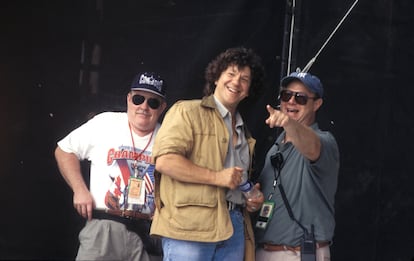
To coincide with the original Woodstock’s 25th anniversary, Lang and his new partner, Scher, launched the peaceful and artistically satisfying sequel to Woodstock in 1994, but they lost money hand over fist. In 1999, they conspired to capitalize on the Woodstock brand once and for all with a professionally conceived and executed event, minus the naïve idealism that had turned previous iterations into ruinous business.
The 1999 festival was held at Griffiss Air Force Base, a decommissioned military base just outside Rome, New York, over 100 miles from Woodstock’s original location. Griffiss was an unsuitable venue for a three-day music campout. It had a huge lot full of asphalt and unkempt grass, and the two main stages were nearly four kilometers apart.
That weekend, the state was experiencing an extreme heat wave; temperatures reached 102.2º F (39º C) degrees that felt like 104º F (40º C), slightly hotter than the heat wave the East Coast is facing this year. An estimated 400,000 people paraded through the ugly, inhospitable outdoor venue that weekend; on Saturday night alone, there were over 250,000 attendees.
From an alternative tribe to an angry mob
According to Heather, who attended the event when she was 14, many began to feel that they were being treated “like animals.” The exorbitant prices at which the commercial tents sold food and drink particularly upset attendees. They charged $4 for a bottle of water (the equivalent of $7today) and between $8 and $10 for a slice of pizza, a sandwich, or a burrito (today, about $18), at an event that had prohibited bringing provisions from outside and for which concertgoers had paid $150 ($266 today).
They were also indignant because of the woefully inadequate waste management service (“we woke up on Saturday morning in a sea of garbage that nobody picked up,” explains Heather), and the portable latrines, many of which burst after a few hours because of overuse, flooded the place with human waste and an indescribable stench.
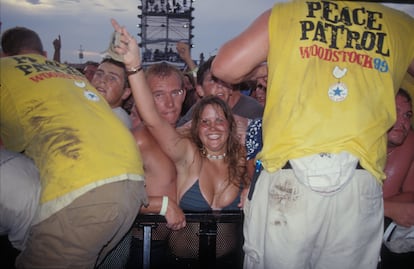
Moreover, as one of the health service workers acknowledges in the documentary, the free fountain water that people used to quench their thirst, shower, and brush their teeth became unsafe to drink. Feces from the latrines contaminated that water. Not only was it undrinkable but in many cases mere contact with it caused skin rashes or lip and gum infections.
The festival lineup did not help improve the mood. Hard rock and nu-metal (a style that mixed hard rock and hip hop and briefly took young white Americans by storm) bands dominated the delirious program. Among those acts were Korn, Creed, Kid Rock and Limp Bizkit, the big stars of the moment. Additionally, there were bands, such as Offspring, Metallica and Rage Against the Machine, whose abrasive sound and visceral discourse were totally alien to the first Woodstock’s spirit of peace and love. Thirty years ago, fans of Joe Cocker and Crosby, Stills, Nash & Young had happily and stoically faced the inconveniences and inclemency of a precariously organized mass event. Janis Joplin had even worried from the stage about their welfare and urged them to complain if they felt they were being treated disrespectfully (“you don’t have to go take anybody’s shit, man… So...if you’re getting more shit than you deserve, you know what to do about it, man.”).
However, as early as Friday, July 23, 1999, it was clear that fans of Korn’s charismatic lead singer, Jonathan Davis, shared with the hippies of three decades earlier only a propensity for public nudity. That concert, described by Ananda Lewis as “an insane explosion of energy,” already demonstrated that the Woodstock ‘99 crowd was not going to be a tame one. Indeed, they were vehement, aggressive young people who were quite willing to push the limits of an atmosphere of freedom and impunity and had little tolerance for the discomfort they experienced. The turning point came during the Limp Bizkit concert on Saturday night. As David Blaustein put it, “three different versions of Fred Durst [the band’s singer] competed on stage.” Durst’s instincts told him that something big was brewing among the crowd of ecstatic and hysterical kids, many of whom were naked. His common sense told him to try to lighten the mood. His ego urged him to become the revolt’s high priest. His ego won. Durst gave a frenetic performance, inciting his audience to give in to their rage and “break everything,” to not resign themselves “to the conformist shit that people like Alanis Morissette [also in the festival’s lineup] want to sell you.” They listened to him. Some audience members stormed and smashed a sound control tower.
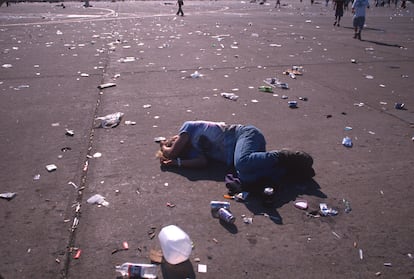
Just off the stage, Durst gave an interview that was as brief as it was revealing:
-Have you ever seen anything like this before, Fred?
-No, I’ve never done anything like that.
-I suppose you’ve seen from the stage that there have been serious incidents.
-Well, yes, but that’s not our fault.
Hours later, the climate of violence moved to the electronic music tent where Norman Cook, better known as Fatboy Slim, was performing. At 2 am, a van suddenly drove onto the dance floor, forcing Cook to stop his performance. When security personnel gained control of the vehicle, they discovered a half-naked and drugged teenage girl inside who exhibited obvious signs of having been gang raped.
Illuminated by fire
But the real disaster occurred on Sunday night during the Red Hot Chili Peppers concert, which ended the festival. It was triggered by an absurd decision that most interviewees attribute to Michael Lang: handing tens of thousands of lit candles to attendees and asking them to perform a spontaneous homage to the victims of the mass shooting at Columbine, which had taken place months before.
Instead, the audience used the candles to set fires. The band ignored the promoters, who’d suggested the band ask for calm on stage. Anthony Kiedis, the lead singer, told an increasingly overwhelmed John Scher that “they wouldn’t listen to me, I’m a musician, not a prophet.” The Red Hot Chili Peppers simply said that the fire at the foot of the stage reminded them of Apocalypse Now. Then, they decided to perform Jimi Hendrix’s Fire as the band’s encore, an inopportune choice.
In the barely three minutes that the song lasted, the three or four existing fires became a dozen. A pitched battle involving thousands of young people followed the concert. The pyromaniac impulse gave way to euphoric violence befitting the novel Lord of the Flies. They razed everything to the ground, leaving the venue in a state that one organizer likened to war-torn Bosnia. They destroyed the commercial tents, broke into cash registers, toppled sound towers, razed the hippie-inspired murals covering the security perimeter, and tried to force their way into the VIP area and the organizers’ offices.
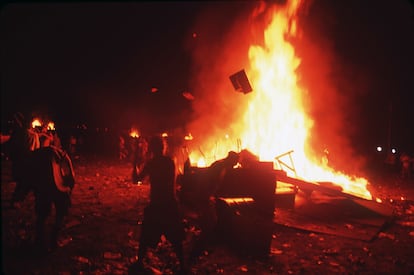
Judy Berman of Time magazine notes that “they vented all the anger [they had] accumulated during three days of aggressive music, inflammatory messages and systematic mistreatment by incompetent and unscrupulous organizers.” Berman contends that “the festival was a complete trainwreck from the beginning; it assumed that 250,000 people could function for three days as a community capable of self-regulating, under conditions of total abandonment by the organizers, [and that] no serious incidents [would take place].”
The Guardian’s Rebecca Nicholson similarly interprets the events, adding that “Woodstock [19]99′s most sinister legacy is the sheer number of rapes and acts of sexual abuse and harassment that took place over those three days,” a consequence of both “poor security” and the “climate of impunity and toxic masculinity that pervaded the rock scene of the late 1990s.” The glorification of nudism, recreational shamelessness, and free love hid “an atrocious machismo and a nauseating lack of respect for women’s sexual freedom.” Ananda Lewis goes further to say that, to some extent, the Me Too movement is “a reaction to the culture of misogynistic abuse that was brought out, very forcefully, at Woodstock ‘99.” But perhaps Heather’s reflection is the farthest reaching. A teenager at the time, a couple of decades later she acknowledges that Woodstock was one of the best weekends of her life. But she also notes that “we don’t accept what happened any more … I’m glad that my daughters will never have to see that and think that is just the way it is.” The disastrous night that live music died 23 years ago still casts a long shadow.
Tu suscripción se está usando en otro dispositivo
¿Quieres añadir otro usuario a tu suscripción?
Si continúas leyendo en este dispositivo, no se podrá leer en el otro.
FlechaTu suscripción se está usando en otro dispositivo y solo puedes acceder a EL PAÍS desde un dispositivo a la vez.
Si quieres compartir tu cuenta, cambia tu suscripción a la modalidad Premium, así podrás añadir otro usuario. Cada uno accederá con su propia cuenta de email, lo que os permitirá personalizar vuestra experiencia en EL PAÍS.
¿Tienes una suscripción de empresa? Accede aquí para contratar más cuentas.
En el caso de no saber quién está usando tu cuenta, te recomendamos cambiar tu contraseña aquí.
Si decides continuar compartiendo tu cuenta, este mensaje se mostrará en tu dispositivo y en el de la otra persona que está usando tu cuenta de forma indefinida, afectando a tu experiencia de lectura. Puedes consultar aquí los términos y condiciones de la suscripción digital.
More information
Últimas noticias
Chris Martin, Taylor Swift, Elijah Wood and other famous wedding ‘crashers’
‘How does it feel to be a failure?’: Elizabeth Berkley’s journey from ‘Showgirls’ ridicule to vindication
The story of the Málaga virus: The code that haunted Google’s cybersecurity center director for 30 years
The impact of Ecuador’s mega-prison: A polluted river, cleared forests and military checkpoints
Most viewed
- Christian Louboutin: ‘Young people don’t want to be like their parents. And if their parents wear sneakers, they’re going to look for something else’
- The low-cost creative revolution: How technology is making art accessible to everyone
- Liset Menéndez de la Prida, neuroscientist: ‘It’s not normal to constantly seek pleasure; it’s important to be bored, to be calm’
- All the effects of gentrification in one corner of Mexico’s Colonia Roma
- December Social Security and SSI payments: Dates, double checks and the 2026 COLA increase
